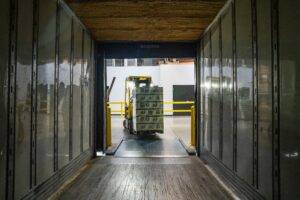An efficient logistics and supply chain management system is crucial to the growth and survival of any company. One of the most crucial elements of the supply chain, warehousing, is frequently disregarded throughout the selection process for logistics partners. Warehouse management software is the glue that keeps everything running smoothly, from stock control to timely order fulfillment.
Warehouses play a crucial role in the distribution of all types of tangible items. The entire supply chain is affected, from the procurement of raw materials through the final delivery of a product to a consumer or retail outlet. Knowing the fundamentals of warehousing solutions and their constituent parts is crucial in light of the ever-increasing complexity and demand for warehouse technology.
What is Warehousing?
The term “warehousing” is commonly used to describe the phase of a supply chain where physical goods are stored before being shipped out for sale. These services are essential to ensure the products are acquired safely and securely before transit. In addition, warehousing systems facilitate efficient distribution by allowing service providers to centrally collect, sort, and ship goods.
When an online store first begins to expand, many of the necessary tasks, such as managing stock and preparing orders for shipment, can be completed from the owner’s living room or spare bedroom. The company’s owners will need specialized warehousing options, though, as their operations grow. The most common methods for accomplishing this are renting or leasing warehouse space, or contracting with a third-party logistics provider.
Why is Warehousing Important?
Almost any company selling tangible things will need a warehouse as part of their supply chain. Business-to-business (B2B) organizations may store goods destined for B2B clients, or consumer-facing businesses may retain goods destined for retail customers. When it comes to brick-and-mortar stores and online marketplaces, warehouses enable:
- Buying products in large quantities that cannot be shown in a shop but may be purchased by individual consumers via the Internet.
- Ordering in bulk helps these companies save money by giving them more leverage when negotiating with their suppliers, which in turn increases their profit margins.
- Having enough stock on hand to meet fluctuating demand.
Warehouses also allow companies to stock products in advantageous locations to cut down on transit times and expenses. Businesses who sell products directly to customers find it advantageous to distribute their stock across the country. In the same vein, if they are selling to customers all over the world, they will want to position warehouses in several locations to facilitate expedited shipping and reduce the number of shipments subject to customs clearance.
The Three Components of Warehousing Solutions
Picking a warehouse partner that is both efficient and technologically reliant is a crucial decision for any company that sells tangible items. Three primary elements make up storage solutions, often known as storage logistics:
1. Managing a Warehouse
Maintaining order and efficiency in a warehouse is the responsibility of the warehouse manager. The primary duty is to keep up the excellent standard set for the upkeep of the warehouse’s operations. This involves dealing with shippers and regulators, managing and training employees, keeping inventories up to date, and keeping goods safe. The primary function of warehouse management is to assess and coordinate the personnel resources required to maintain warehouse operations without jeopardizing worker security.
The warehouse’s owner should also check that all necessary permits are in order. Effective warehouse management involves carrying out tasks and making strategic plans to streamline the process.
2. Warehouse Operations
All warehouse operations aim to facilitate the inbound and outgoing flow of products. Keeping tabs on stock levels is also an integral part of the procedure. This systematic procedure is founded on the fundamental principles of warehousing. It includes:
- Receiving inventory.
- Managing every Stock Keeping Unit by keeping them at a specified place.
- Assuring the safe and secure delivery of these products to the end-user.
Warehouse operations, though often disregarded, are a crucial part of warehousing solutions since they assist in keeping everything in sync, cut expenses, and guarantee goods on-time delivery. Keeping tabs on stock levels allows warehouses to stock up on what’s needed for shipments and maximize square footage to maximize profits.
3. Warehouse Management Systems
While the fundamentals of effective warehousing solutions have mostly stayed the same over time, technological advancements have made the entire process more efficient and effective. The third part of ware, a warehouse management system (WMS), is responsible for making this a reality. A WMS, or warehouse management system, is software that helps organizations with tasks like inventory management and warehouse operations.
The goal is to free up time that can be better spent on more critical activities by doing away with time-consuming manual procedures. To improve efficiency throughout the supply chain, from sourcing materials to final delivery, warehouse management systems are built to monitor and analyze the flow of inventories.
Factors to Consider in Warehousing
Although warehousing appears straightforward at first glance because it primarily entails leaving things in storage, there are actually quite a few processes needed to guarantee it is done efficiently and inventory can be transferred in and out rapidly.
- The Art of Capacity Planning
The most important commodity is free space. Therefore, in order to make the most efficient use of storage space, workers need to anticipate where products will be put when a shipment is expected.
- Receiving Inbound Shipments
Products need to be properly unloaded from delivery vehicles and transferred to a staging area in the warehouse before they can be processed.
- Monitoring Stock Levels
Warehouse inventory management software is used to keep track of incoming and outgoing goods so that managers are aware of stock levels and can anticipate demand.
- Holding Stock
Products require storage following receipt and processing. Products can be stored in bins or on pallets, and then moved with forklifts or other heavy machinery.
- Weather Modification
Constant conditions may be required, such as temperature, humidity, or pressure, depending on the goods being stored. Products that need to be kept frozen, for instance, require storage facilities with temperatures well below freezing. Storage methods and locations inside the facilities will need to be adjusted to meet these standards, so that items retain their intended quality.
- Reorganizing
To make the best use of the available space as new products are added, it may be necessary to reorganize the current stock. The inventory management systems must be kept current with any changes.
- Extraction and dispatch
When things are ready to be shipped out, the warehouse employees must retrieve, process, package, load, and release them from inventory to make room for fresh incoming products.
Warehousing and the Supply Chain
When it comes to the distribution of tangible goods, warehousing plays a crucial role in the overall process. Warehouses play an important role in the supply chain as intermediate storage facilities, but they also help supply chain managers save money by facilitating more efficient inventory management, shipping, and delivery. Things like repackaging goods for marketing purposes or to optimize the package for last-mile delivery are also possible thanks to the convenience of warehousing. To give your customers the greatest possible experience with your firm, it’s crucial that your items make it through the supply chain to them.
Choose Right Warehousing Solutions Provider
Due to the increased complexity of the supply chain, warehouses have become an increasingly vital component to its overall success. Everything from storing raw materials to transporting them to manufacturers to transporting finished products from manufacturers to warehouses, assembling them, and delivering them to their final destination is delicate and must be treated with care. You need to stay on top of all warehouse activities to keep your supply chain running smoothly. Consider I-Way’s comprehensive warehousing and logistics services if you need advice on warehouse management or wish to have this task performed by a third party.




